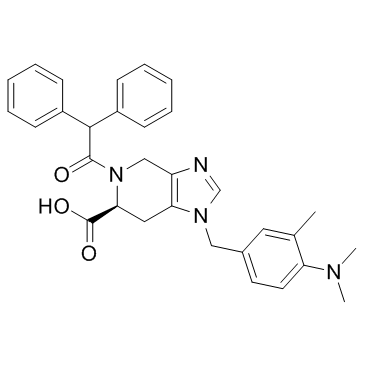130663-39-7
| Name | pd123319 |
|---|---|
| Synonyms |
1H-Imidazo[4,5-c]pyridine-6-carboxylic acid, 1-[[4-(dimethylamino)-3-methylphenyl]methyl]-5-(2,2-diphenylacetyl)-4,5,6,7-tetrahydro-, (6S)-
(S)-1-<<4-(dimethylamino)-3-methylphenyl>methyl>-5-(diphenylacetyl)-4,5,6,7-tetrahydro-1H-imidazo<4,5-c>pyridine-6-carboxylic acid (6S)-1-[4-(Dimethylamino)-3-methylbenzyl]-5-(diphenylacetyl)-4,5,6,7-tetrahydro-1H-imidazo[4,5-c]pyridine-6-carboxylic acid trifluoroacetate (1:2) (6S)-1-[4-(Dimethylamino)-3-methylbenzyl]-5-(diphenylacetyl)-4,5,6,7-tetrahydro-1H-imidazo[4,5-c]pyridine-6-carboxylic acid 1H-Imidazo[4,5-c]pyridine-6-carboxylic acid, 1-[[4-(dimethylamino)-3-methylphenyl]methyl]-5-(2,2-diphenylacetyl)-4,5,6,7-tetrahydro-, (6S)-, compd. with 2,2,2-trifluoroacetic acid (1:2) (3S)-9-[(4-DIMETHYLAMINO-3-METHYL-PHENYL)METHYL]-4-(2,2-DIPHENYLACETYL)-4,7,9-TRIAZABICYCLO[4.3.0]NONA-7,10-DIENE-3-CARBOXYLIC ACID 1-((4-(Dimethylamino)-3-methylphenyl)methyl)-5-(diphenylacetyl)-4,5,6,7-tetrahydro-1H-imidazo[4.5-c]pyridine-6-carboxyli PD 123,319 PD 123,319 DITRIFLUOROACETATE pd 123,319 di(trifluoroacetate) salt 1H-Imidazo(4,5-c)pyridine-6-carboxylic acid, 1-((4-(dimethylamino)-3-methylphenyl)methyl)-5-(diphenylacetyl)-4,5,6,7-tetrahydro-, (S)- S-(+)-1-((4-(dimethylamino)-3-methylphenyl)methyl)-5-(diphenylacetyl)-4,5,6,7-tetrahydro-1H-imidazol(4,5-c)pyridine-6-carboxylic acid PD 123319 |
| Description | PD 123319 (ditrifluoroacetate) is a potent, selective AT2 angiotensin II receptor antagonist with IC50 of 34 nM. |
|---|---|
| Related Catalog | |
| Target |
IC50: 34 nM (AT2 Receptor)[1] |
| In Vitro | PD 123319 is shown to discriminate between two subclasses of AII receptors in many different tissues. 125I-AII specifically label two classes of binding sites for AII in a membrane preparation of bovine adrenal glomerulosa cells. The first class (DuP-753 sensitive) represents approximately 85% of the total binding sites for AII and possesses a high affinity (IC50 of 92.9 nM) for DuP-753. PD-123319 does not have any effect on 125I-AII binding to this site. The second class of binding sites is more sensitive to PD-123319, with an IC50 of 6.9 nM, and has a much lower affinity for DuP-753 (IC50 around 10 microM)[2]. |
| Animal Admin | The lower limit of CBF autoregulation is studied in 16 SHR. Eight animals receive PD 123319, while eight serve as controls. PD 123319 or saline is administered intravenously, and the BP is allowed to stabilise for 10 minutes after the injection and prior to the commencement of the autoregulation study. Haemorrhagic hypotension is subsequently induced by withdrawing blood into a syringe. By this means, BP is reduced stepwise to the lowest obtainable level. Throughout the study, CBF is measured at 10 to 15 mmHg BP intervals. |
| References |
| Density | 1.2±0.1 g/cm3 |
|---|---|
| Boiling Point | 775.8±60.0 °C at 760 mmHg |
| Molecular Formula | C31H32N4O3 |
| Molecular Weight | 508.61 |
| Flash Point | 423.0±32.9 °C |
| PSA | 78.67000 |
| LogP | 4.40 |
| Appearance | powder |
| Vapour Pressure | 0.0±2.8 mmHg at 25°C |
| Index of Refraction | 1.641 |
| Storage condition | 2-8°C |
| Water Solubility | H2O: 12 mg/mL |
